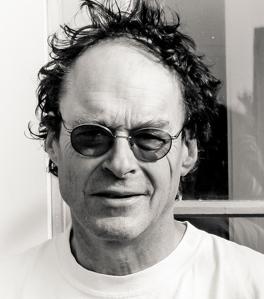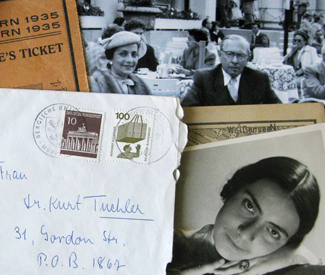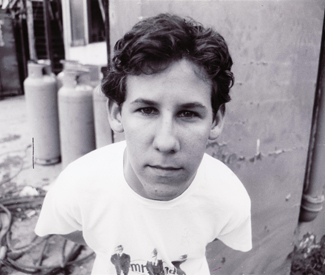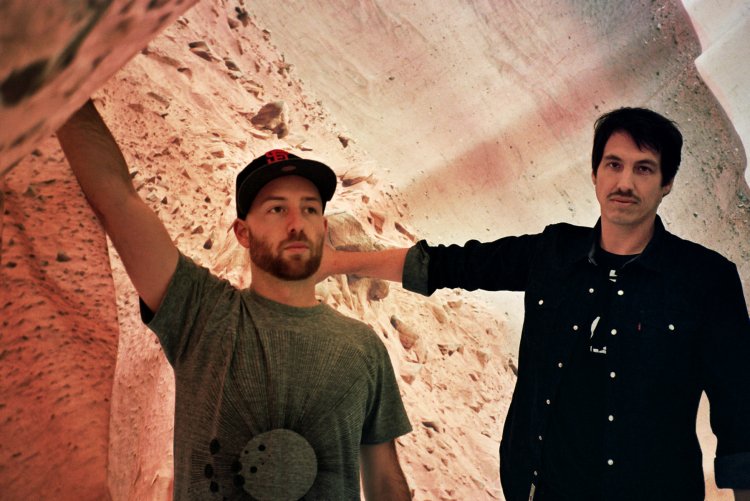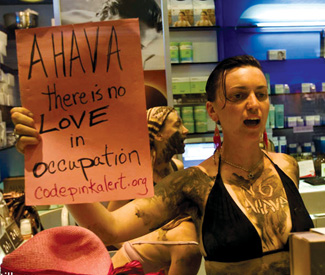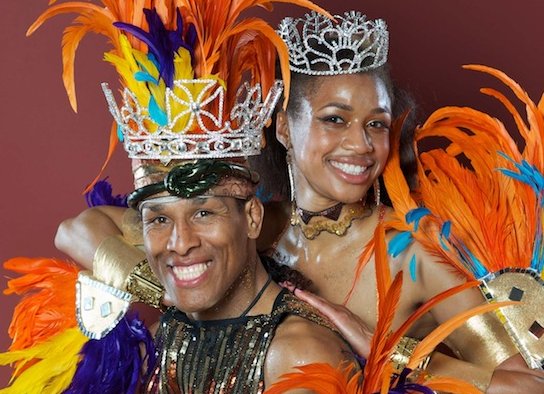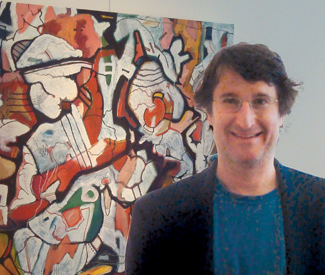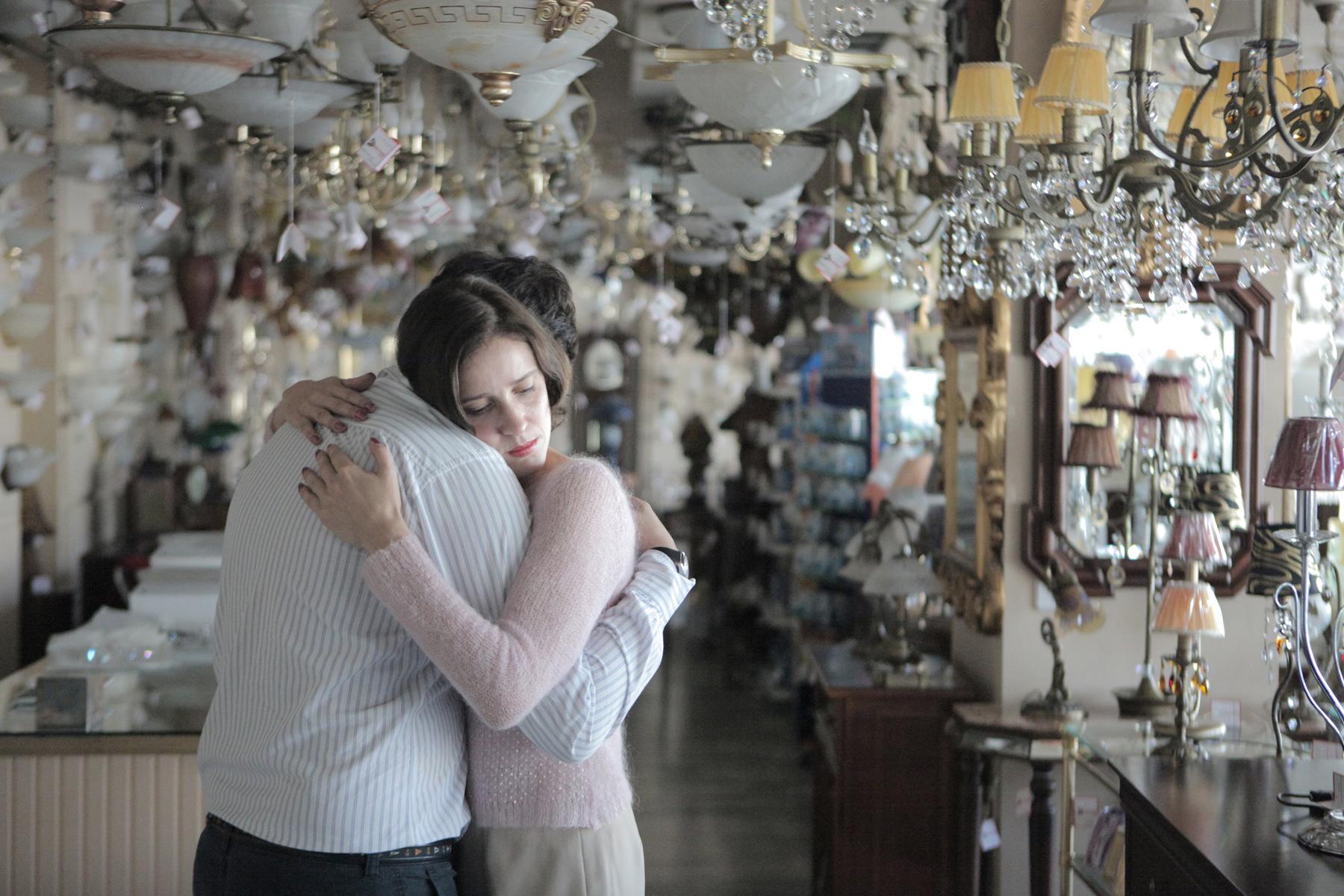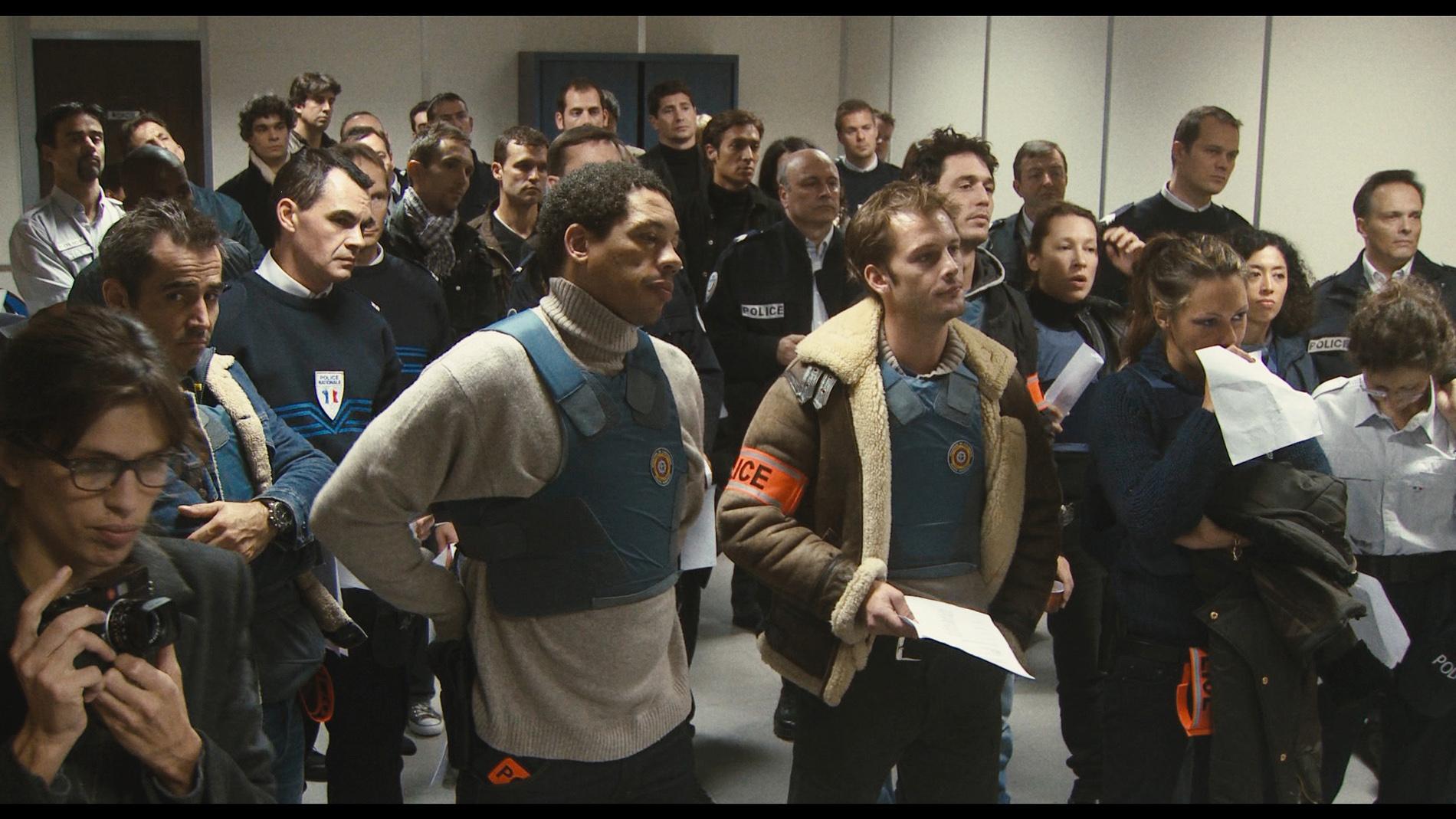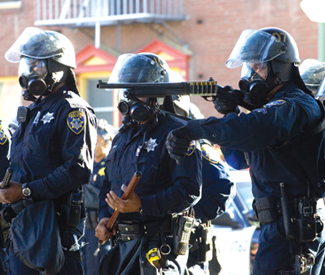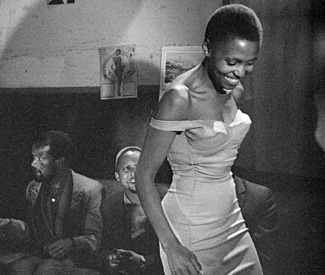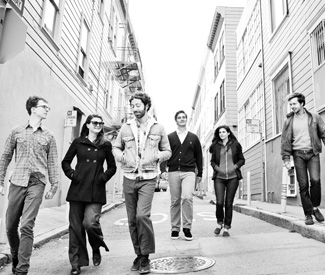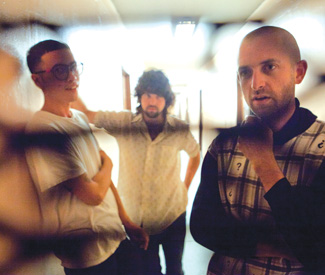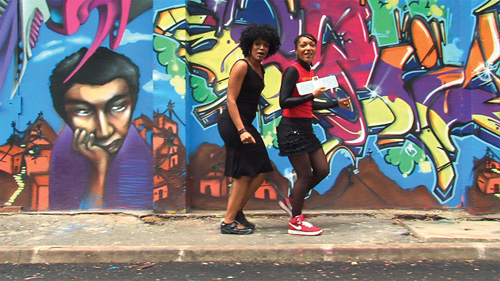Since club life is unpredictable, it’s a good idea to call ahead or check the venue’s website to confirm bookings and hours. Prices are listed when provided to us. Visit www.sfbg.com/venue-guide for venue information. Submit items for the listings at listings@sfbg.com. For further information on how to submit items for the listings, see Picks.
WEDNESDAY 6
ROCK/BLUES/HIP-HOP
Brendan Benson, Young Hines, Howling Brothers Independent. 8pm, $18.
Brian Bergeron Johnny Foley’s. 9pm, free.
Bob vs. Greg Zema Johnny Foley’s Dueling Pianos. 9:30pm.
Church of Misery, Hail! Hornet, Gates of Slumber Elbo Room. 8pm, $18.
CocoRosie, Tez and the Rajasthan Roots, Sissy Nobby Regency Ballroom. 8pm, $25.
Keith Crossan Invitational Pro Jam Biscuits and Blues. 8 and 10pm, $15. With Terry Hanck.
Rocco Deluca Brick and Mortar Music Hall. 9pm, $8-$10.
Early Novembers, Wonder Years, Swellers, Young Statues Slim’s. 7:30pm, $20.
Guitar Wizards of the Future, Beatcasso Hemlock Tavern. 9pm, $5.
Mansions on the Moon, Deer Tracks, Nouela Bottom of the Hill. 9pm, $12.
One Way Station Boom Boom Room. 8pm, $5.
Teen Daze, One AM Radio, Giraffage, Slow Magic Rickshaw Stop. 8pm, $10-$12.
Nick Waterhouse Verdi Club, 2424 Mariposa, SF; www.verdiclub.net. 8pm, $12. With DJs Carnita, Primo, Matt B, Lucky.
JAZZ/NEW MUSIC
Cat’s Corner with Nathan Dias Savanna Jazz. 9pm, $10.
Cosmo AlleyCats Le Colonial, 20 Cosmo Place, SF; www.lecolonialsf.com. 7-10pm.
Dink Dink Dink, Gaucho, Michael Abraham Amnesia. 7pm, free.
Thomas Mapfumo & Blacks Unlimited Yoshi’s SF. 8pm, $22.
Candace Roberts 50 Mason Social House, SF; www.50masonsocialhouse.com. 7pm.
Ricardo Scales Top of the Mark, 999 California, SF; www.topofthemark.com. 6:30pm, $5.
DANCE CLUBS
Booty Call Q-Bar, 456 Castro, SF; www.bootycallwednesdays.com. 9pm. Juanita MORE! and Joshua J host this dance party.
Coo-Yah! Som., 2925 16th St, SF; (415) 558-8521. 10pm, free. DJs Daneekah and Green B spin reggae and dancehall with weekly guests.
Mary Go Round Lookout, 3600 16th St, SF; www.lookoutsf.com. 10pm, $5. Drag with Suppositori Spelling, Mercedez Munro, and Ginger Snap.
Megatallica Fiddler’s Green, 1333 Columbus, SF; www.megatallica.com. 7pm, free. Heavy metal hangout.
Obey the Kitty: Yolanda Be Cool Vessel, 85 Campton, SF; www.vesselsf.com. 10pm, $10.
THURSDAY 7
ROCK/BLUES/HIP-HOP
Advance Base, Nicholas Krgovich, David Joanna Cafe Du Nord. 8pm, $10-$12.
Mickey Avalon, Millionaires, Dirt Slim’s. 7:30pm, $20.
Rick Derringer Yoshi’s SF. 8pm, $26.
General 50 Mason Social House, SF; www.50masonsocialhouse.com. 7pm.
Grendel’s Claw, Curse Words, Grandma’s Boyfriend, Sweet Bones Knockout. 9:30pm, $6.
Human Condition, Betsy and Beau, Quiet Man Bottom of the Hill. 9pm, $10.
Laurie Morvan Band Biscuits and Blues. 8 and 10pm, $15.
JD McPherson Great American Music Hall. 8pm, $21.
Idina Menzel Davies Symphony Hall, 201 Van Ness, SF; (415) 864-6000. 8pm, $69.50-$125.
Misisipi Mike and the Midnight Gamblers, Heeldraggers Amnesia. 9pm, $7-$10.
Party Owl, T.I.T.S, Burrows Hemlock. 9pm, $6.
Stan Erhart Band Johnny Foley’s. 9pm, free.
Wailers, Gondwana Mezzanine. 9pm, $30.
Greg Zema vs. Bob Johnny Foley’s Dueling Pianos. 9:30pm.
JAZZ/NEW MUSIC
Stompy Jones Top of the Mark, 999 California, SF; www.topofthemark.com. 7:30pm, $10.
Ned Boynton Trio Bottle Cap, 1707 Powell, SF; www.bottlecapsf.com. 7-10pm.
FOLK/WORLD/COUNTRY
Twang! Honky Tonk Fiddler’s Green, 1330 Columbus, SF; www.twanghonkytonk.com. 5pm. Live country music, dancing, and giveaways.
DANCE CLUBS
Afrolicious Elbo Room. 9pm, $5. With DJ-host Pleasuremaker spins Afrobeat, Tropicália, electro, samba, and funk.
Base: Sasha Vessel, 85 Campton, SF; www.vesselsf.com. 10pm, $20.
Get Low Som., 2925 16th St, SF; (415) 558-8521. 10pm, free. Jerry Nice and Ant-1 spin Hip-Hop, 80’s and Soul with weekly guests.
Midi Matilda, Young Digerati, popscene DJs Rickshaw Stop. 9:30pm, $10-$12.
OneMama & M.O.M. Dance Party and Fundraiser 111 Minna, SF; www.onemama.org. 5:30-11pm.
Supersonic Lookout, 3600 16th St., SF; www.lookoutsf.com. 9pm. Global beats paired with food from around the world by Tasty. Resident DJs Jaybee, B-Haul, amd Diagnosis.
Thursdays at the Cat Club Cat Club. 9pm, $6 (free before 9:30pm). Two dance floors bumpin’ with the best of 80s mainstream and underground with DJ’s Damon, Steve Washington, Dangerous Dan, and guests.
Tropicana Madrone Art Bar. 9pm, free. Salsa, cumbia, reggaeton, and more with DJs Don Bustamante, Apocolypto, Sr. Saen, Santero, and Mr. E.
FRIDAY 8
ROCK/BLUES/HIP-HOP
Bob, Joel Nelson, Greg Zema Johnny Foley’s Dueling Pianos. 9pm.
Body & Soul Johnny Foley’s. 9pm, free.
Concussion, Jack Killed Jill, Ill Content, Bankrupt District Sub-Mission. 8:30pm, $5.
Christopher Cross Yoshi’s SF. 8pm, $40; 10pm, $35.
Face to Face, Downtown Struts Slim’s. 7:30pm, $20.
Falsetto Teeth, Zu Zed, Bob Ladue Brainwash Cafe, 1122 Folsom, SF; www.brainwash.com. 8pm, free.
Forward, No Statik, Merdoso, Effluxus Knockout. 8pm.
Hollyhocks Makeout Room. 7:30pm.
Maus Haus, Exray’s, Mwahaha, Devonwho Rickshaw Stop. 8pm, $10.
New Orleans Suspects, Zigaboo Modeliste and the New Aahkesstra Brick and Mortar Music Hall. 9pm, $15-$20.
Cathy Richardson Biscuits and Blues. 8 and 10pm, $20.
Bob Schneider, Laura Warshauer Independent. 9pm, $20.
Starskate, Hazel’s Wart, Girls In, Wes Leslie and His Deadly Medley Thee Parkside. 9pm, $6.
Tender, DickWolf, Inferno of Joy, Yes Go’s Hemlock. 9:30pm, $6.
This Will Destroy You, A Place To Bury Strangers, Dusted Bottom of the Hill. 10pm, $14.
Tornado Rider, Battlehooch, Kill Moi, Sporting Life Great American Music Hall. 8pm, $13.
Whiskerman, Guy Fox, Tumbleweed Wanderers, Steve Taylor Cafe Du Nord. 8pm, $10-$12.
JAZZ/NEW MUSIC
Audium 1616 Bush, SF; www.audium.org. 8:30pm, $20. Theater of sound-sculptured space.
Black Market Jazz Orchestra Top of the Mark, 999 California, SF; www.topofthemark.com. 9pm, $10.
Terry Disely Bottle Cap, 1707 Powell, SF; www.bottlecapsf.com. 5:30-8:30pm, free.
FOLK/WORLD/COUNTRY
Jay Schraub Coffee Adventures, 1331 Columbus, SF; (415) 441-0301. 11am-1pm, free.
Taste Fridays 650 Indiana, SF; www.tastefridays.com. 8pm, $18. Salsa and bachata dance lessons, live music.
Usual Suspects Acoustic Showcase 50 Mason Social House, SF; www.50masonsocialhouse.com. 8pm.
DANCE CLUBS
Forro Brazuca Elbo Room. 10pm, $10. Hottest dancehall music from Brazil.
Future Perfect Public Works. With Jel, GuMMy Bear, Friendzone, Jaycasio, and more.
Glitter DNA Lounge. 9pm, $10-$20. Techno, tech-house, and electronic dance.
Indie Slash Amnesia. 10pm. With DJ Danny White.
Joe Lookout, 3600 16th St.,SF; www.lookoutsf.com. 9pm. Eight rotating DJs, shirt-off drink specials.
MartyParty 103 Harriet. 1am, $15.
Old School JAMZ El Rio. 9pm. Fruit Stand DJs spinning old school funk, hip-hop, and R&B.
Paris to Dakar Little Baobab, 3388 19th St, SF; (415) 643-3558. 10pm, $5. Afro and world music with rotating DJs including Stepwise, Steve, Claude, Santero, and Elembe.
SATURDAY 9
ROCK/BLUES/HIP-HOP
Bow Wow Regency Ballroom. 8pm, $32.
Christopher Cross Yoshi’s SF. 8pm, $40; 10pm, $35.
Corrosion of Conformity, Torche, Black Cobra, Gaza Slim’s. 8pm, $21.
Cut Loose Band Johnny Foley’s. 9pm, free.
Donavon Frankenreiter, Goodnight Texas Independent. 9pm, $21.
Funk Revival Orchestra: A Tribute to Roy Ayers Cafe Du Nord. 9:30pm, $10.
Green Lady Killers, Flexx Bronco Bender’s, 800 S. Van Ness, SF; www.bendersbar.com. 9pm, $5.
Hightower, Pins of Light, Ironwitch, War Child Thee Parkside. 3pm, free.
“Indie-Pino” Yerba Buena Center for the Arts Sculpture Garden, Third and Mission, SF; ybca.org/indie-pino. 1-6pm, free. With Savages, Pedro Gil, Golda and the Guns, Jack Lords Orchestra, Good Night Robot.
Maps & Atlases, Big Sleep, Hands Bottom of the Hill. 10pm, $15.
New Orleans Suspects, Zigaboo Modeliste and the New Aahkesstra Brick and Mortar Music Hall. 9pm, $15-$20.
Julia Nunes Swedish American Hall. 8pm, $15.
Rod Piazza & the Mighty Flyers Biscuits and Blues. 8 and 10pm, $22.
Pierced Arrows, Don’t, Abatis Thee Parkside. 9pm, $12.
Randy, Greg Zema, Bob Johnny Foley’s Dueling Pianos. 9pm.
Shannon & the Clams, Burnt Ones, Cool Ghouls, In Watermelon Sugar El Rio. 3-8pm, $8.
Spidermeow, Rabbles, Mt. Whateverest Hemlock. 9:30pm, $7.
Tiny Television Riptide, 3639 Taraval, SF; www.riptidesf.com. 9:30pm, free.
JAZZ/NEW MUSIC
Audium 1616 Bush, SF; www.audium.org. 8:30pm, $20. Theater of sound-sculptured space.
FOLK/WORLD/COUNTRY
Bay Area Swing All-Stars 50 Mason Social House, SF; www.50masonsocialhouse.com. 7pm.
San Francisco Free Folk Festival Presidio Middle School, 450 30th Ave, SF; noon-10pm, free.
“Twang Bang” Great American Music Hall. 8:30pm, $13-$15. With Dirty Hand Family Band, Famous, Shants, Rogers, Hot Pink.
Craig Ventresco & Meredith Axelrod Atlas Cafe, 3049 20th St, SF; www.atlascafe.net. 4-6pm, free.
DANCE CLUBS
Club Gossip Cat Club. 9pm, free before 9:30pm, $5-$8 after. With VJs Shon, Low Life, Damon, and more.
Cockblock Rickshaw Stop.10pm, $5-$10.
Non Stop Bhangra: LA to the Bay Public Works. 9pm, $15.
Paris to Dakar Little Baobab, 3388 19th St, SF; (415) 643-3558. 10pm, $5. Afro and world music with rotating DJs including Stepwise, Steve, Claude, Santero, and Elembe.
Pink and Purple Patio Party Cafe Cocomo, 650 Indiana, SF; www.cafecocomo.org. 1-7pm, $10. Queer outdoor dance party with DJs and free barbecue.
Soul Slam 7: Michael Jackson vs. Prince Mezzanine. 9pm, $25.
Tormenta Tropical Elbo Room. 10pm, $5-$10. With Shawn Reynaldo & Oro11, DJ Dodger Stadium.
2 Men Will Move You Amnesia. 9pm.
SUNDAY 10
ROCK/BLUES/HIP-HOP
Nicki Bluhm and the Gramblers, Blank Tapes Rickshaw Stop. 7:30pm, $10.
Elegant Trash, Warbler, Johnny Lowrie Band Hemlock. 9pm, $6.
Green River Ordinance, Jesse Thomas Bottom of the Hill. 9pm, $12.
John Lawton Trio Johnny Foley’s. 9pm, free.
Ray Wylie Hubbard, Elliot Randall Cafe Du Nord. 8:30pm, $17-$20.
Patrick Watson, Cat Marino Great American Music Hall. 8pm, $16-$19.
Unknown Hinson Independent. 8pm, $20.
Emily Jane White Brick and Mortar Music Hall. 9pm, $5-$8.
Still Flyin, Tambo Rays, Trails and Ways Rickshaw Stop. 7pm, $10.
JAZZ/NEW MUSIC
Josh Klipp Bliss Bar, 4026 24th St, SF; www.blissbar.com. 4:30pm, $10.
Fabiana Passoni & Her All-Star Band Yoshi’s SF. 7Pm, $16.
FOLK/WORLD/COUNTRY
Balkan Beat Box Israel In the Gardens Festival, 750 Howard, SF; Facebook: Israel in the Gardens 2012. 3pm, free
Lagos Roots Afro Beat Ensemble Boom Boom Room. 8pm, $5.
San Francisco Free Folk Festival Presidio Middle School, 450 30th Ave, SF; noon-10pm, free.
DANCE CLUBS
Activate! After After Hours Monroe, 473 Broadway, SF; www.monroesf.com. 6am-2pm, $10. With Emanate, James Henderson, Joseph Lee, and Zenith.
Dub Mission Elbo Room. 9pm, $6. Dub, roots, and classic dancehall with DJ Sep, J. Boogie, Mochi Pet.
Jock Lookout, 3600 16th St, SF; www.lookoutsf.com. 3pm, $2. Raise money for LGBT sports teams while enjoying DJs and drink specials.
La Pachanga Blue Macaw, 2565 Mission, SF; www.thebluemacawsf.com. 6pm, $10. Salsa dance party with live Afro-Cuban salsa band
MONDAY 11
ROCK/BLUES/HIP-HOP
Catch Hell, Feral Cat, Death By Steamship Rock Loft, 471 Broadway, SF; (415) 846-5124. 9pm, $5.
Damir Johnny Foley’s. 9pm, free.
Priester’s Cue Yoshi’s SF. 8pm, $18.
Sidekicks, Spraynard, Delay, Wild Moth Bottom of the Hill. 8:45pm, $8.
Sticklers, Pony Time, Creepers Hemlock. 6pm, $5.
Y Axes, Tarantula Tango, Scatter Gather, Loud Talker Elbo Room. 9Pm, $6.
Wax Idols, White Lung Knockout. 9pm.
JAZZ/NEW MUSIC
Bossa Nova Tunnel Top, 601 Bush, SF; (415) 722-6620. 8-11:30pm, free. Live acoustic Bossa Nova.
Timmy Igoe Band Rrazz Room. 7:30pm, $25.
FOLK/WORLD/COUNTRY
Toshio Hirano Amnesia. 9pm.
Pick: Open Bluegrass Jam Amnesia. 6pm.
DANCE CLUBS
Death Guild DNA Lounge. 9:30pm, $3-5. Gothic, industrial, and synthpop with Joe Radio, Decay, and Melting Girl.
Krazy Mondays Beauty Bar, 2299 Mission, SF; www.thebeautybar.com. 10pm, free. Hip-hop and other stuff.
M.O.M. Madrone Art Bar. 6pm, free. DJs Timoteo Gigante, Gordo Cabeza, and Chris Phlek playing all Motown every Monday.
Vibes’N’Stuff El Amigo Bar, 3355 Mission, SF; (415) 852-0092. 10pm, free. Conscious jazz and hip-hop from 1960s-early ’90s with DJs Luce Lucy, Vinnie Esparza, and more.
TUESDAY 12
ROCK/BLUES/HIP-HOP
Alvon Biscuits and Blues. 8 and 10pm, $22.
Bombshell Betty and Her Burlesqueteers, Fromagique Elbo Room. 9pm, $10.
King Loses Crown, High Society, Parade Bottom of the Hill. 9pm, $8.
Here We Go Magic, Harriet Independent. 8pm, $15.
Leopold & His Fiction, Rusty Maples Hemlock. 9pm, $7.
Merrill Bazaar Cafe, 5927 California, SF; www.bazaarcafe.net. 7pm, free.
Rhapsody of Fire, Voyager Slim’s. 8pm, $27.
Stan Erhart Band Johnny Foley’s. 9pm, free.
Thrice, Animals As Leaders, O’Brother Regency Ballroom. 7:30pm, $25.
JAZZ/NEW MUSIC
Gaucho Bottle Cap, 1707 Powell, SF; www.bottlecapsf.com. 7-10pm, free.
“Jazz Voices of Poetry” Yoshi’s SF. 8pm. With Clairdee, Nicolas Beare, Shanna Carlson.
Ben Vereen Rrazz Room. 8pm, $45-$50.
FOLK/WORLD/COUNTRY
Dustbowl Revival, Devine’s Jug Band St. Cyprian’s, 2097 Turk, SF; www.noevalleymusicseries.com. 7:30pm, $18.
DANCE CLUBS
Eclectic Company Skylark, 9pm, free. DJs Tones and Jaybee spin old school hip hop, bass, dub, glitch, and electro.
Post-Dubstep Tuesdays Som., 2925 16th St, SF; (415) 558-8521.10pm, free. DJs Dnae Beats, Epcot, Footwerks spin UK Funky, Bass Music.
Study Hall John Colins Lounge, 138 Minna, SF; www.johncolins.com. 9pm. Hip-hop, dancehall, and Bay slaps with DJ Left Lane.

